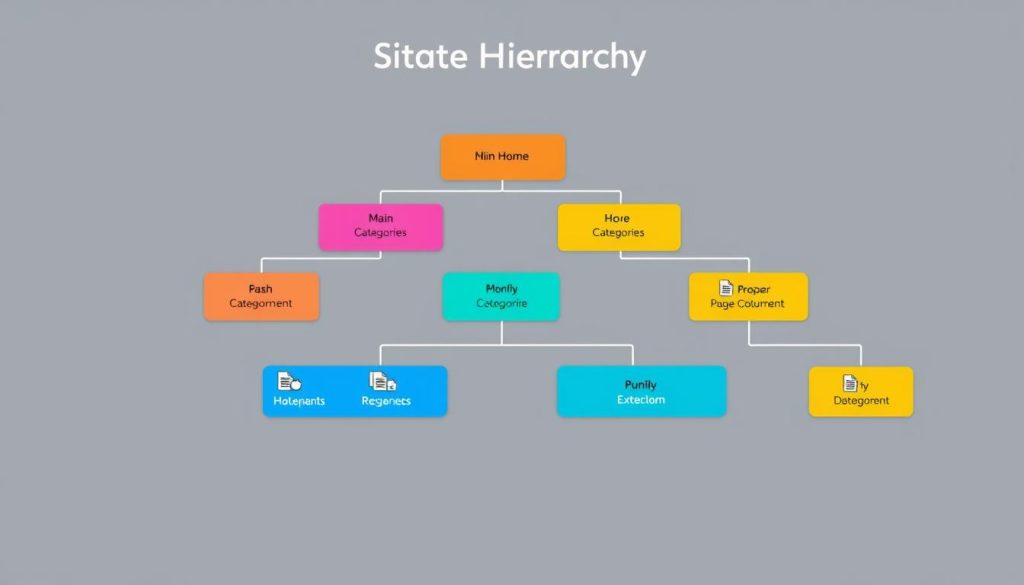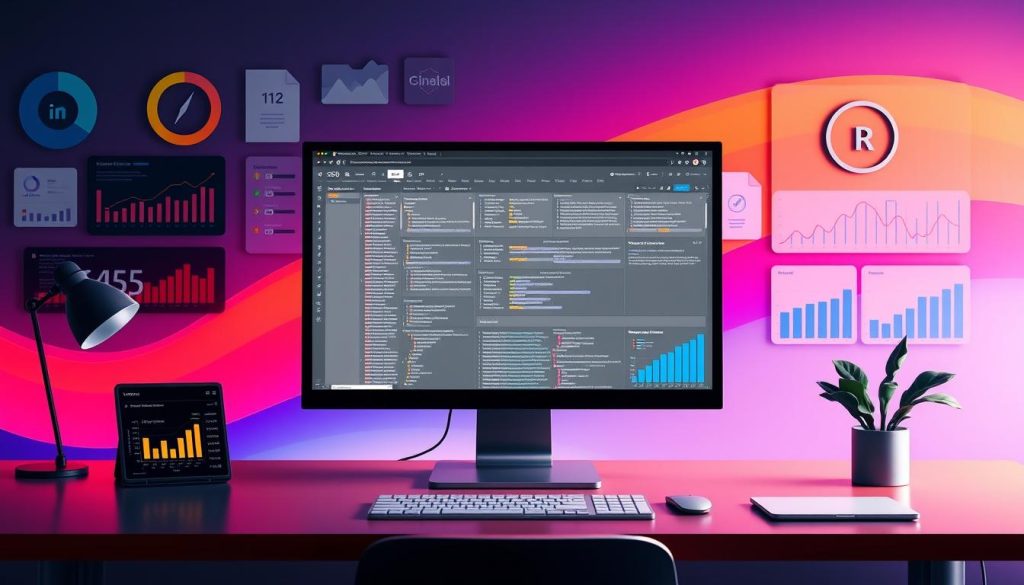Mastering technical SEO is key to climbing the search engine ranks. As the digital world changes, optimising your website’s technical aspects is more important than ever. This guide will cover the essential elements of technical SEO, helping you boost your site’s performance and visibility.
We’ll explore the critical aspects that can greatly affect your website rankings. Whether you’re an experienced professional or new to the field, grasping these technical SEO basics will give your site a competitive edge in today’s online world.
For those aiming to elevate their technical SEO, consider the help of hosting providers like LerriHost. They offer optimised hosting solutions that can enhance your technical SEO efforts. This ensures your website operates smoothly and efficiently.
Key Takeaways
- Technical SEO is essential for improving search engine rankings
- Site architecture and URL structure play a critical role in optimisation
- Mobile optimisation is non-negotiable in today’s digital landscape
- Page speed significantly impacts user experience and rankings
- Security implementation, including HTTPS, is vital for SEO success
- Regular technical SEO audits help maintain and improve site performance
Understanding Technical SEO Fundamentals
Technical SEO is the foundation of a website’s visibility in search results. It optimises technical aspects to boost performance in search engine algorithms. This is essential for better crawling, indexing, and user experience.
The Role of Technical SEO in Search Engine Rankings
Search engines employ complex algorithms to rank websites. These algorithms assess various technical factors to determine a site’s position. An optimised website facilitates easier crawling and indexing, resulting in higher rankings.

Core Components of Technical Optimisation
Technical SEO includes several critical elements:
- Site structure and navigation
- Page speed and loading times
- Mobile-friendliness
- Secure connections (HTTPS)
- XML sitemaps
Each component is vital for search engine perception and ranking. For example, LerriHost highlights the significance of optimised server configurations for faster page loading.
Why Technical SEO Matters in 2024
Technical SEO’s importance grows as search engines advance. In 2024, it’s more vital than ever due to:
- Increased focus on user experience signals
- Mobile-first indexing
- Core Web Vitals as ranking factors
Keeping up with these technical aspects ensures your site remains competitive. A technically sound website satisfies search engines and enhances user experience.
Site Architecture and URL Structure Best Practices
A well-structured website is essential for SEO success. It ensures search engines can crawl and index your content efficiently. It also enhances user experience. Let’s dive into key aspects of site architecture and URL structure that can elevate your rankings.
Creating SEO-Friendly URLs
URL optimisation is critical for search engine rankings. LerriHost’s SEO services highlight the need for clear, concise URLs. Incorporate descriptive keywords, avoid unnecessary parameters, and keep them brief. For instance:
- Good: www.example.com/blue-widgets
- Bad: www.example.com/products?id=123&category=widgets&colour=blue
Implementing Proper Site Hierarchy
A logical site hierarchy enhances website navigation and clarifies content structure for search engines. Organise your pages into categories and subcategories. This creates a clear path from the homepage to specific content. It benefits both users and search engines in finding information swiftly.

Managing Internal Linking Structure
Internal linking is a powerful tool for distributing link equity and guiding users. Implement a strategic internal linking plan to connect related content and highlight key pages. This practice boosts SEO and user engagement by providing valuable navigation paths.
| Internal Linking Best Practices | Benefits |
|---|---|
| Use descriptive anchor text | Improves contextual relevance |
| Link to relevant, high-quality content | Enhances user experience |
| Maintain a natural link density | Avoids over-optimisation penalties |
| Update links regularly | Ensures fresh, relevant connections |
By adhering to these site architecture and URL structure best practices, you’ll lay a solid foundation for your SEO efforts. This will improve both search engine visibility and user satisfaction.
Mobile Optimisation Strategies

In today’s digital world, mobile optimisation is essential for website success. Smartphones have become ubiquitous, leading Google to adopt mobile-first indexing. This means mobile-friendly sites now take precedence in search results. It highlights the importance of responsive design, ensuring your site works well on all screen sizes.
A responsive design is vital for a better mobile user experience. It eliminates the need for separate mobile sites, cutting down on maintenance costs. It also ensures consistency across devices. LerriHost provides hosting solutions that support responsive designs, leading to faster mobile load times.
To optimise for mobile, consider these strategies:
- Simplify navigation for touch screens
- Optimise images for faster loading
- Use legible fonts and appropriate text sizing
- Implement accelerated mobile pages (AMP) for lightning-fast loading
Mobile optimisation is not just about looks; it’s about creating a seamless user journey. By focusing on these areas, you’ll see better performance in mobile search results. You’ll also provide a superior experience for your mobile visitors.
| Mobile Optimisation Factor | Impact on User Experience | SEO Benefit |
|---|---|---|
| Responsive Design | Consistent experience across devices | Improved mobile rankings |
| Fast Loading Speed | Reduced bounce rates | Higher search engine visibility |
| Touch-Friendly Navigation | Easier site exploration | Increased time on site |
Page Speed Optimisation Techniques
Enhancing page load time is essential for both user satisfaction and search engine rankings. We will explore effective methods to increase your site’s speed and server performance.
Server Response Time Improvement
Decreasing server response time is critical for better site speed. Opt for a reliable hosting provider with optimised servers. LerriHost provides robust solutions for WordPress, ensuring quick response times.
Image Optimisation Methods
Image compression is vital for reducing page load times. Utilise tools to compress images without compromising quality. Implementing lazy loading for off-screen images is also beneficial.

Cache Management
Effective caching strategies can greatly enhance site speed for repeat visitors. Implement browser caching to store static assets locally on users’ devices. Server-side caching reduces database queries and speeds up content delivery.
Code Minification Strategies
Code optimisation involves minimising CSS, JavaScript, and HTML files. This process removes unnecessary characters without affecting functionality, leading to smaller file sizes and faster loading times.
| Optimisation Technique | Impact on Speed | Implementation Difficulty |
|---|---|---|
| Server Optimisation | High | Medium |
| Image Compression | High | Low |
| Caching | High | Medium |
| Code Minification | Medium | Low |
By applying these techniques, you can significantly boost your website’s speed and performance. This will lead to enhanced user satisfaction and better search engine rankings.
XML Sitemaps and Robots.txt Configuration

XML sitemaps and robots.txt files are vital for guiding search engine crawlers through your website. They are key for effective sitemap optimisation and managing crawl directives.
XML sitemaps serve as roadmaps for search engine crawlers, helping them find and index your content efficiently. To create an optimised sitemap:
- Include all important pages
- Categorise pages logically
- Update regularly to reflect changes
- Submit through search console tools
The robots.txt file controls crawler access to specific areas of your site. When configuring your robots.txt:
- Use disallow directives judiciously
- Avoid blocking critical resources
- Specify the location of your sitemap
LerriHost offers seamless integration for both XML sitemaps and robots.txt configuration. This ensures your site’s visibility to search engine crawlers is optimised.
| Element | Purpose | Key Considerations |
|---|---|---|
| XML Sitemap | Guide crawlers to content | Comprehensive, up-to-date, properly structured |
| Robots.txt | Control crawler access | Clear directives, avoid over-restriction |
Regular monitoring and updates to these files are essential for maintaining optimal crawlability and indexation of your website. By mastering these technical SEO elements, you’ll significantly enhance your site’s visibility in search results.
HTTPS and Security Implementation
In today’s digital world, website security is essential. HTTPS and strong security measures protect your site and enhance search engine rankings. We’ll look at securing your website and optimising it for search engines.
SSL Certificate Installation
SSL certificates are vital for HTTPS migration. They encrypt data between users and your site, ensuring privacy and security. LerriHost makes SSL installation easy, streamlining the process for website owners.

Security Headers Configuration
Security headers add a protective layer to your website. They prevent common attacks and boost your site’s security. Adding headers like Content-Security-Policy and X-Frame-Options strengthens your website’s defence.
Mixed Content Issues Resolution
HTTPS migration can lead to mixed content issues. These happen when secure HTTPS pages load resources over insecure HTTP. Fixing these issues is key to a fully secure site and avoiding browser warnings that scare off visitors.
| Security Measure | SEO Impact | User Trust |
|---|---|---|
| SSL Certificates | Improved rankings | High |
| Security Headers | Enhanced credibility | Medium |
| HTTPS Migration | Positive ranking factor | High |
Implementing these security measures protects your website and boosts its search engine visibility. A secure site builds trust with users, which is vital for SEO and online success.
Technical SEO Audit Essentials
A detailed SEO audit is vital for a website’s health. It uncovers and resolves issues that could affect your site’s search engine ranking. Let’s dive into the essential parts of a thorough technical SEO audit.
Crawlability Assessment
It’s critical that your site is crawlable by search engine bots. LerriHost’s crawler is useful for spotting blocked resources, broken links, and incorrect redirects. Fixing these crawl errors quickly boosts your site’s visibility.

Indexation Status Check
Keep an eye on which pages are indexed by search engines. Google Search Console’s index coverage report is a good tool for this. Look out for and fix common issues like:
- Noindex tags on key pages
- Duplicate content
- Orphaned pages
Error Detection and Resolution
A website health check must identify and fix technical errors. Look for issues such as:
- 404 errors
- Broken internal and external links
- XML sitemap errors
- Slow loading pages
Regular SEO audits and addressing these technical points lay a strong foundation for your site’s search engine performance. A well-optimised site not only ranks higher but also offers a better user experience.
Structured Data and Schema Markup
Structured data and schema markup are key to boosting your website’s visibility in search results. They provide search engines with detailed context about your content. This leads to the display of rich snippets and enhances semantic search capabilities.

Schema.org, a joint project by major search engines, offers a standardised vocabulary for structured data. This markup helps search engines grasp the content and relationships on your web pages. It enables more precise indexing and display of information.
JSON-LD (JavaScript Object Notation for Linked Data) is a widely used format for structured data. It’s simple to read and maintain, making it a favourite among webmasters and SEO professionals.
Benefits of Structured Data
- Enhanced search result appearance
- Improved click-through rates
- Better understanding of content by search engines
- Potential for featured snippets
LerriHost advises using structured data to enhance your website’s visibility and improve user experience. Proper schema markup implementation can give your site a competitive edge in search results.
| Schema Type | Use Case | Potential Rich Snippet |
|---|---|---|
| Product | E-commerce websites | Price, availability, reviews |
| Recipe | Cooking websites | Cooking time, ingredients, ratings |
| Event | Event websites | Date, location, ticket information |
Ensure your structured data implementation is correct by testing it with tools from search engines. This will help maximise its effectiveness in boosting your site’s search visibility.
Content Delivery and Performance
Optimising content delivery is key to better website performance. This section delves into strategies to enhance your site’s speed and user experience.
CDN Implementation
A content delivery network (CDN) spreads your website’s content across servers globally. This cuts down latency for users worldwide, making your site load faster. LerriHost makes CDN integration smooth, ensuring quick access to your site for all visitors.

Browser Caching Optimisation
Effective caching strategies can greatly reduce server load and boost repeat visits. By setting the right cache headers, you tell browsers to store static assets locally. This makes subsequent page loads quicker, as unchanged files don’t need to be re-downloaded.
Asset Compression Techniques
File compression is a strong tool for website performance improvement. By shrinking the size of CSS, JavaScript, and images, you can significantly reduce load times. Here are some effective compression methods:
- Minify CSS and JavaScript files to remove unnecessary characters
- Use modern image formats like WebP for better compression without quality loss
- Enable GZIP compression on your server to reduce file transfer sizes
By implementing these content delivery and performance optimisations, you can see better search rankings and a superior user experience. A faster website not only delights visitors but also search engines.
Core Web Vitals Optimisation
Core web vitals have become essential Google ranking factors, influencing the page experience for users. These metrics focus on three critical aspects of website performance.

LCP (Largest Contentful Paint)
LCP measures the speed at which a page’s main content loads. To enhance this, optimise images, leverage efficient hosting like LerriHost, and reduce render-blocking resources. Aiming for an LCP score under 2.5 seconds is key.
FID (First Input Delay)
FID assesses a site’s interactivity by measuring the time from a user’s first interaction to the browser’s response. To improve FID, reduce JavaScript execution time and break up long tasks. Aim for an FID of less than 100 milliseconds.
CLS (Cumulative Layout Shift)
CLS evaluates visual stability by quantifying unexpected layout shifts. To reduce CLS, set size attributes for images and videos, avoid inserting content above existing content, and use transform animations for smoother transitions. Strive for a CLS score below 0.1.
Optimising these core web vitals boosts your Google rankings and enhances user experience on your website. Regular monitoring and fine-tuning of these metrics are vital for maintaining top performance in search results.
JavaScript SEO Considerations
JavaScript is now a fundamental part of web development, enabling dynamic content and single-page applications. It, though, brings unique SEO challenges. It’s vital to grasp these hurdles to ensure your site remains crawlable and improves its search rankings.

JavaScript rendering is a major SEO concern. Search engines must run JavaScript to uncover content, affecting crawling efficiency. To tackle this, consider server-side rendering for key content. This method ensures search engines can easily find and index your site’s main parts.
Dynamic content, often loaded asynchronously, can be hard for search engines to find. To improve crawlability, adopt progressive enhancement techniques. Begin with a basic HTML structure that includes your essential content, then add JavaScript functionality. This approach makes your site accessible, even if JavaScript doesn’t load.
Single-page applications (SPAs) present specific SEO hurdles. Their client-side rendering can cause indexing problems. To overcome this, implement effective URL routing and consider frameworks like Next.js or Nuxt.js that support server-side rendering.
“Balancing the power of JavaScript with SEO best practices is essential for modern websites to thrive in search results.”
LerriHost provides optimised hosting solutions that boost JavaScript rendering performance. Their advanced caching and content delivery networks improve both user experience and search engine crawlability.
- Use server-side rendering for critical content
- Implement progressive enhancement
- Optimise SPAs with proper URL routing
- Leverage hosting solutions like LerriHost for improved performance
By tackling these JavaScript SEO issues, you can build dynamic, interactive websites that retain search engine visibility. The aim is to find a balance between rich functionality and optimal crawlability.
International SEO Implementation
Expanding your online presence globally demands a solid international SEO strategy. This strategy ensures your content reaches the right audience across various languages and regions. Let’s dive into the key elements of multilingual SEO that can enhance your global visibility.
Hreflang Tag Usage
Hreflang attributes are vital for international targeting. They inform search engines about the language and regional variants of your web pages. Proper use helps avoid duplicate content issues and ensures users see the most relevant version of your site.

Geotargeting Configuration
Effective geotargeting is key to reaching specific country audiences. This involves setting up country-specific domains or subdomains and configuring them in search console. LerriHost offers reliable hosting solutions that support seamless global content delivery, boosting your international SEO efforts.
Content Localisation Strategies
Localised content is more than just translation. It involves adapting your content to resonate with local cultures, customs, and search behaviours. This strategy improves user engagement and boosts your site’s relevance in different markets.
| SEO Element | Impact on International SEO |
|---|---|
| Hreflang Tags | Directs users to correct language versions |
| Geotargeting | Improves visibility in specific countries |
| Content Localisation | Enhances relevance and user engagement |
By integrating these international SEO techniques, you can significantly improve your global online presence. Success in multilingual SEO requires ongoing optimisation and adaptation to local search trends.
Conclusion
Technical SEO best practices are essential for a strong SEO strategy. By applying the methods discussed, you’ll see better search rankings and more visibility. Remember, technical SEO is ongoing – it’s vital to keep optimising to stay competitive in the digital world.
Every aspect, from site architecture to mobile optimisation, is key to your website’s success. Focus on page speed, security, and Core Web Vitals for a smooth user experience. Don’t overlook the importance of structured data and international SEO to expand your reach.
Begin your technical SEO journey with the most impactful changes for your site. Keep up with the latest SEO trends and algorithm updates to maintain a cutting-edge strategy. For expert help, LerriHost provides services designed to improve your technical SEO and enhance your website’s performance.
